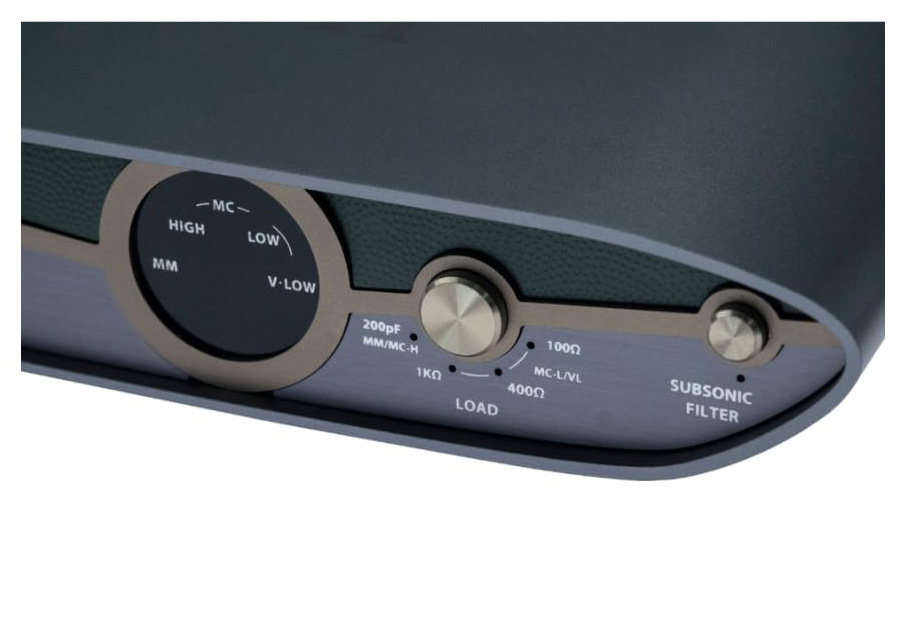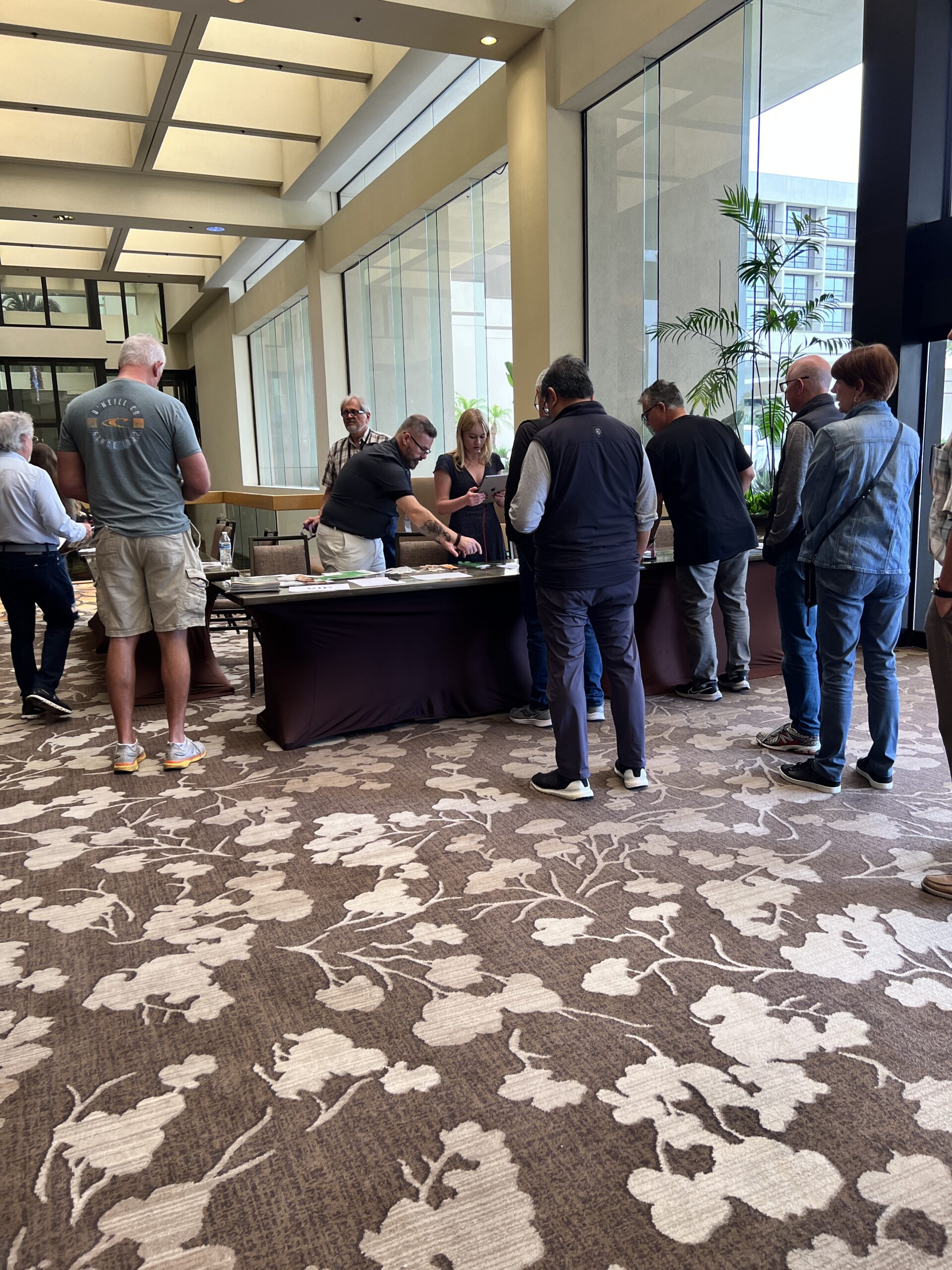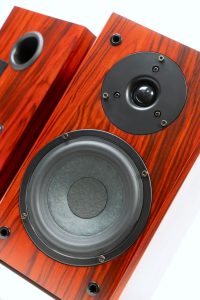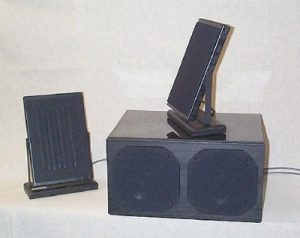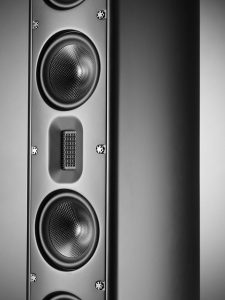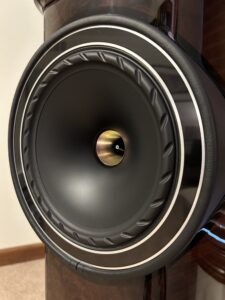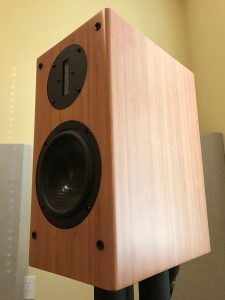For many years my music has been enjoyed through small, two-way stand mounted speakers. Although ones listening room usually dictates the size of the speaker they purchase, my 12X20 foot den can accommodate speakers bigger than a stand mount monitor. And it has. My current speakers are floor standers and fit quite nicely in that room performing to their full capability. Therefore, it was a welcome surprise that I was asked to review the NSMT Model 100 speakers. The Model 100 is a floor standing full range design from their Performance series. Actually, it has been a number of years since I last had a NSMT speaker in my home.
Back in the March/April 2011 issue of our illustrious mag, I had the pleasure of reviewing NSMT's Audio Mastering Series M100 Loudspeakers. Aside from the 7-inch concentric driver, they were very close in design to the new M100. a quick look at my old review and it was pretty obvious that I heaped a good amount of praise on them. And rightly so. Except for a slight warmth in the upper registers and the odd choice of running a set of wires outside the back of the speakers from tweeter to woofer, they were an excellent pair of speakers. My comments were… deep powerful bass…grip on dynamics…realistic soundstage… solid image placement… very grainless and clean presentation…very lifelike manner… natural tone… fun. That is a lot for the new M100 to live up to.
Unpacking the Model 100 would make any gear lover worth his salt proud. These 44-inch-high monoliths are a solidly packed, intelligently designed, full assault on a full range floor stand design. These are the most solidly built speakers I have ever seen. There are no flexible spots on this cabinet.
Setting up these speakers was a snap. They fit almost in the same spot that my Tonian Labs TL-D1 resides. Due to their sensitivity of 91 W/M, I happen to have a few low watt Class D amplifiers to try with the monitor half of the speakers. As well as my main bevy of amplifiers which include both solid state and tube. I also seem to recall buying NSMT's own Lepai based modified Stereo Class T Digital Audio Amplifier a few years ago after I reviewed it. I am sure that amp will see some service before the review is finished.
One area of apprehension for me is the sub-woofer section. My experience with subwoofers is limited at best. I have owned two subwoofers in my time, both of which while living in my current home. My biggest problem is integrating them with the main speakers. Aside with my limited experience with their ilk, I was never satisfied with the way they blended with my main speakers. It's not that I am an obsessive-compulsive audiophile or anything. But along with the task of perfectly blending a sub-sat system seamlessly, I always have a nagging feeling that the whole thing is never going to sound right. I did tell you that I am not an obsessive-compulsive audiophile, didn't I? And that is pretty much the case when I try to install a subwoofer in my system. But fear not, Mr. Erol Rickets had the forethought to include instructions to dial in the sub section with the rest of the M-100's. We shall see how that worked out.
The Model 100 Loudspeakers from NSMT are designed with so many features that not mentioning every aspect of its components seems like a disservice to our readers. Besides it is almost tradition or protocol and logical to describe such things in a review. But that information is a few clicks away on their website. Instead of the usual roll call of its design features I will pair them down to the basics and go from there.
"The Model 100 is a time coherent, minimum phase, positive polarity, hybrid design combining a two-way acoustic suspension monitor section with a bandpass subwoofer section." An eight-inch woven carbon woofer is mounted on the top front of the cabinet. Above that and sitting in its own sealed box and set back a few inches on the top of the cabinet in a steeped time aligned configuration is the one inch tweeter. There is a felt shroud that is placed in front of this set back tweeter to reduce reflections. The active bass section uses a 10-inch paper cone subwoofer in a bandpass design. Frequency response is 20 to 200Hz for the subwoofer section. It is driven by a 200-watt amplifier with an active crossover with phase and volume controls. Interestingly the 8-inch carbon fiber is crossover less. It covers the frequency range from 35Hz to 4.75kHz. NSMT states the tweeter integrates with the woofer with a 6Db slope which covers the frequencies from 4.75kHz to 20kHz.
Other notable features are bi-amp/bi-wire capable binding posts. The cabinets are made from formaldehyde free (an NSMT staple) birch plywood and MFD. Water based nontoxic paints are also used in the manufacture. Customers have the option to use spikes or castors which are included. Each speaker weighs 82 pounds. The dimensions are 44 x 12.5 x 12.5 (HWD). The magnetic grill cloths are quite sturdily made yet very functional and nice looking. A limited 10-year warranty is included. Well, this turned out to be a little more than a roll call!
I used several different amplifiers with my listening sessions. I wanted to get a feel how the 8-inch woofer and tweeter sections would sound with what are quite different amplifier designs. I started out with my trusty modified Marantz integrated. This amp is my reference and the workhorse of the bunch. Through it the music sounded quick, clean, dimensional but slightly up-front sounding and very slightly warm and smooth. It never sounded bright or harsh unless the recording dictated the proceedings. Bass was solid and controlled. Switching over to my Margules U280SC Anniversary Edition tube amp proved rewarding. The Margules opened up the soundstage and clarity. There was a slight noticeable improvement in transparency. In other words, it was a bit easier to hear into the soundstage. That soundstage was also a bit more open. Tubes, what can one say. Installing my Antique Sound Labs mono block KT-88 tube based amps proved interesting.
Driving the M100's without the subs, the ASL's proved to sound brighter in the top end. For instance, the vocals and cymbals on the album Steely Dan's Greatest Hits didn't suffer gladly. Particularly the tracks "Bodhisattva" and "Show Biz Kids". My notes read peaky, sibilant and bright for the cymbals with the ASL's. The same phenomenon came through when I played Jack Johnson's Sleep Through the Static CD. Kicking in the subs helped to balance out the sound but didn't totally alleviate the situation. I still felt the top end sounded too bright with the ASL amps. I have had a sneaking suspicion that these amps were a little bright. I don't know if it was an impedance mismatch or I went too far with the modifications to them. This was something that my Tonian Labs speakers may have been slightly masking. I felt there was a mismatch with these amps so out they went.
I was already to proceed with the review using the Margules amp. But to make a long story short one of the KT-88 Sophia Electric tubes developed a distortion. Switching out for a set of Electro-Harmonix KT-88s proved this to be the case. To avoid confusion for the review and to lessen the risk of blowing something up, out went the Margules and in went the Marantz and on to the review. Looks like solid state saved the day this time.
Using these speakers without their powered subs proved to be rewarding. I mean we have a speaker that is quite capable of reproducing music and movies from 35Hz to 20kHz. That is quite a spread for a woofer and tweeter. And in this configuration, we are talking about from 35Hz to 20kHz. There was no roll off in the bass before the 35Hz, no roll off of the treble. That treble is very extended and clean. In this configuration, I felt its most positive attribute among many was the way this speaker handled dynamics. This speaker tracks dynamics like a bloodhound. Dynamics are solid and quick. For instance, on the Jack Johnson CD, Sleep through The Static, I noticed dynamic shifts and emphasis in his vocals through the track, "All at Once" that I have never quite heard before. There are spots in the song when he takes a breath or strains to push a little more air out to emphasis the end of a word that was heard quite clearly. On track 4, "Angel" I heard very realistic strumming sounds from his acoustic guitar. The sharp chirping sounds his fingers made when he was moving them up and down the fret grabbing notes sounded sharp, clear but realistic. And on track 7, "Same Girl", it's like I had my ear up to the air hole of his acoustic guitar. Yet the music never sounded artificial. It retained its naturalness and drew you into the performance. I really enjoyed listening to this track. In fact, I really love this whole album. It was like I was in the studio with Jack.
Yet all of this clarity, detail and dynamics sounded natural and not overdone for the sake of reproducing good stereo. Another good example of this is on the Steely Dan Greatest Hits double album. Again, on the track "Bodhisattva" all of the instruments on this track sounded individual yet collectively on the soundstage. In other words, it was easy to track individual instruments but also easy to just relax into the music and follow the whole song. This track sounded more dimensional and less flat than I have heard it before. This was very good for a non "audiophile" studio recording. This drew me into this very familiar music easily. For the fun of it I compared the vinyl and CD version of the song, "Show Biz Kids". With the vinyl version I heard smoother vocals, the top end was slightly more laid back, it was more dimensional, more coherent and a little warmer sounding than the CD. I sat back and enjoyed three sides of this double album. This illustrates the resolving power and musical ability of these speakers. Vinyl, who would have thought.
I mentioned above my lack of experience with sub-woofer dial in. I needn't have worried. Erol Ricketts sub instructions were spot on. I had these two built in subs dialed in in no time. On with the full Monty. With the M100s in full range mode on went the soundtrack to the movie The Comedian by Terrence Blanchard. Great movie, great soundtrack. On track 1, "Jackie in the Rain", Blanchard's trumpet sounded clean, realistic and dynamic. Kenny Barron's piano sounded solid and weighty pushing out crystal clear notes. His piano had that slight warmth like the real instrument. This CD also features Carl Allen and David Pulpus on bass, Ravi Coltrane on sax and Khari Allen Lee on alto sax. Track 4, "Electricity on Macdougal", is an up-tempo composition. The bass portion of the M-100 doesn't miss a beat. No lagging, bloat or one note sound whatsoever. Bass sounded solid, taut and extended. My notes read, "very close to a live Jazz combo in my room". I haven't had a live jazz combo playing at my house. But I have heard one at a friend's house. What also might have prompted my comment here was the fact that with the subs on, the soundstage opened up and let the music stretch out and open up. In fact, in that soundstage I heard exact placement of instruments and a solid rendering of space and dimension. If it is a good recording like the Johnson or Blanchard disks, you will be rewarded with this aspect of its performance.
Next up was the John Lester Quartet's Jazz CD. This is Lester and his gang doing their jazzy versions of contemporary pop/rock fair. What prompted me to buy this disk was that I heard Lester's version of the Pink Floyd song, "Money" on Spotify in my car. OK, this sounds intriguing! On the Counting Crows composition, "Mr. Jones", this music sounded big, spacious, dynamic and very natural. Those two woofers were doing justice to that upright bass. Bass notes came out not too tight, not bloaty but just right. Bass noted sounded full, deep and resonate coming from a shapely big wooden box. Again, the M-100's handled the dynamics from the piano and upright bass with solidity and finesse.
Next, I moved on to something completely different than acoustic jazz. The Cliff Martinez' synth driven soundtrack to the movie The Neon Demon. This soundtrack is as interesting as the movie. Here the M100's was pumping out deep solid synth sounds and vocals of all kinds from this CD. Again, I heard solid, full and taut deep bass with solid dynamics. The extended and very clean highs were never too sharp or bright on this CD. These speakers have the ability to wring out the minutest of detail without fatigue.
For my next hat trick, I pulled out a real gem. It is another soundtrack on vinyl, this time to a movie called, Clan of the Cave Bear from 1986. It starred Daryl Hannah and the music was composed by Alan Silvestri. I have had this movie on DVD for many years. I bought the album recently. A few days ago, I watched a documentary about cave art by the talented director, Werner Herzog. It was a fantastic depiction of as yet undiscovered cave art found in a cave in France dating back 30,000 years. The problem with this film was its music. It was chamber music. If ever there was a disappointing connection between a films subject matter and music this was it. The Clan of the Cave Bear soundtrack from the movie of the same name on the other hand fit the film perfectly. It is atmospheric, ethereal and romantic all at the same time. It sounds very primitive without slipping into a cliché. Of particular note was track 7, "Kreb on the Mountain". The drum sounds sounded, spacious, deep, dynamic and solid. As with the main title, blending this with the upper registers of the Synclavier made for an experience that took you back to pre-history. It did me anyway.
While we are in the same genera, one disk that literally flabbergasted me when hearing it was the soundtrack to The Emerald Forest. Yes, I know another soundtrack. On track 7, "The Burning of the Dead", the M100's reproduced the deepest most powerful most realistically textured bass drum whacks that I have ever heard. I don't actually know what kind of drum they used, but it sounded so realistic. I have played this CD many times through a number of systems over the years. But I have never heard that particular cut so fantastically reproduced as through these speakers. I finished off this listening with a few disks from Robert Rich and was transported to musical bliss.
Next for some rock and roll fun I played Lonnie Mac, The Wham of that Memphis Man, The Shadows of Knight, Live 1966, and Doug Sham and Band from 1973. I picked up these albums on Record Store Day 2017. The Mack album from Alligator Records has some of the slickest lead guitar I have ever heard. The Shadows of Knight is the solid precursor to Punk Rock a decade later. The Sham record is reminiscent of later work he will do with the Super Tex-Mex group, The Texas Tornados. These albums never ventured past the inside edge of the speakers as far as soundstage was concerned. And they wouldn't be accused of being called great recordings. But it is great music. The M-100 easily showed the less than stellar recording quality of these records. But to its credit, the music was still highly enjoyable. In other words, if you have mediocre recordings in your collection and who doesn't, don't be afraid to play them on these speakers.
It goes without saying that movies were a lot of fun running through these speakers. My regular movie watching system is two channel stereo. But my speakers don't have built in subs. Watching movies in this set up, dialog can be compromised. I noticed less of this when watching movies through the M-100 speaker system due no doubt to their great ability to reproduce exact images. Also, the M-100 clearly showed me just how deficient my regular speakers handle deep bass on movies. I guess the old saying is true. "There is no replacement for displacement."
I promised to hook up the little NSMT modified Lepai Class D amplifier to the woofer/tweeter section and I did. Hooked up and playing music sans subs, the music sounded fantastic. And this was with only two minutes warm up. OK, the music sounded slightly less transparent, just slightly. And it did sound a tad rough, just a tad in spots. Oh, wait didn't I say that the Lepai wasn't warmed up? Don't Class D amps take a few days to come on song? An hour later I could hear slight improvements. I heard an accurate tonal balance, natural timbres, nice decay of instruments and I could play the system as loud as I wanted with this little amp in the system thanks to the efficiency of the woofer/tweeter section of the M-100. Kicking in the subwoofers was icing on the cake. For sheer irony and bang for the buck, this was the best amp I used with the M-100's. Save yourself some money and invest in some kind of remote for the little Lepai because it doesn't come with one. While you're at it go and tell the emperor he is naked. This little amp can cook and it thoroughly embarrassed the hell out of the amps I have laying around my house. ABX anyone?
I couldn't resist slipping my Tonian TL-D1 and Fritz Morels in the system for a bit of comparison. Not surprisingly the Tonian's are quite resolving speakers in their own right. They sound a bit more relaxed and they are definitely more efficient. But as I have felt for a while they sounded just a tad thin and have a very slight bit of coloration compared to the M-100. For instance, the trumpet on the Blanchard CD just sounded more realistic through the M-100's. The Fritz's on the other hand were closer in timbre to the M-100, but are noticeably less efficient. They surprised me. They put up a pretty good fight compared to the bigger and more expensive speakers. The NSMT M100 easily sailed past the Morels though in resolution, sheer weight and an exacting soundstage and image recreation, as they should for a speaker many times more expensive. But it was a fun and somewhat ear opening experiment.
Downsides? They are expensive. Almost twice as much from the old M100's. But there is quite a bit of quality material in these two compact towers. Aesthetics. I have seen prettier speakers. But they say beauty is in the eye of the beholder.
So, did the new M-100's live up to their pedigree? They did so and then some. The NSMT M-100 loudspeakers are among many things a master of dynamics. They reproduce music with a high degree of resolution. They are capable of reaching their rated frequency response specs with ease. Their reproduction of timber and tone is very natural and very realistic. And they are built like the proverbial Abrams tank. Mix that all together and you have one hell of a musical speaker very capable of easily drawing you into whatever you listen to with the greatest of ease. They are deserving of the best ancillary equipment and are very capable of competing with speakers quite a bit more expensive than their asking price. They reward the user with care in matching equipment. But they run quite nicely with very modest gear as proven by my use of the little Lepai amp. They are built by a very reputable company in the good old United States of America. And are built with the environment in mind. Start saving your pennies.
Model 100
Retail: $8995 to $9995
NSMT Loudspeakers
919.244.8777





